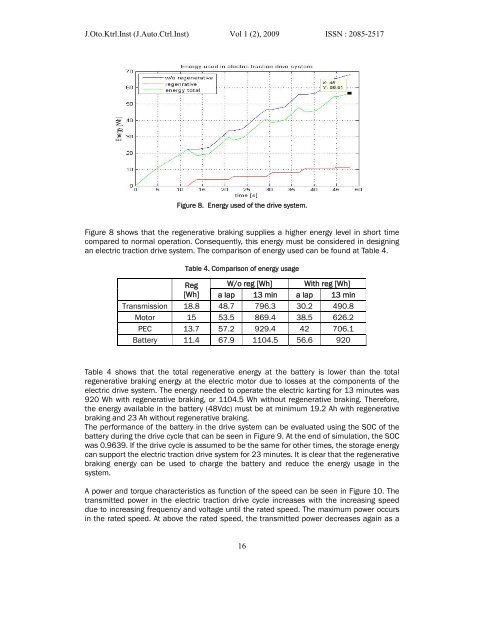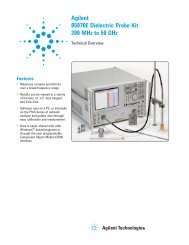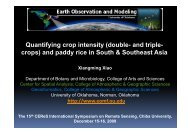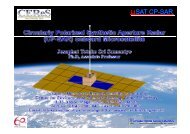Create successful ePaper yourself
Turn your PDF publications into a flip-book with our unique Google optimized e-Paper software.
J.Oto.Ktrl.Inst (J.Auto.Ctrl.Inst) Vol 1 (2), 2009 ISSN : 2085-2517<br />
Figure 8. Energy used of the drive system.<br />
Figure 8 shows that the regenerative braking supplies a higher energy level in short time<br />
compared to normal operation. Consequently, this energy must be considered in designing<br />
an electric traction drive system. The comparison of energy used can be found at Table 4.<br />
Table 4. Comparison of energy usage<br />
Reg W/o reg [Wh] With reg [Wh]<br />
[Wh] a lap 13 min a lap 13 min<br />
Transmission 18.8 48.7 796.3 30.2 490.8<br />
Motor 15 53.5 869.4 38.5 626.2<br />
PEC 13.7 57.2 929.4 42 706.1<br />
Battery 11.4 67.9 1104.5 56.6 920<br />
Table 4 shows that the total regenerative energy at the battery is lower than the total<br />
regenerative braking energy at the electric motor due to losses at the components of the<br />
electric drive system. The energy needed to operate the electric karting for 13 minutes was<br />
920 Wh with regenerative braking, or 1104.5 Wh without regenerative braking. Therefore,<br />
the energy available in the battery (48Vdc) must be at minimum 19.2 Ah with regenerative<br />
braking and 23 Ah without regenerative braking.<br />
The performance of the battery in the drive system can be evaluated using the SOC of the<br />
battery during the drive cycle that can be seen in Figure 9. At the end of simulation, the SOC<br />
was 0.9639. If the drive cycle is assumed to be the same for other times, the storage energy<br />
can support the electric traction drive system for 23 minutes. It is clear that the regenerative<br />
braking energy can be used to charge the battery and reduce the energy usage in the<br />
system.<br />
A power and torque characteristics as function of the speed can be seen in Figure 10. The<br />
transmitted power in the electric traction drive cycle increases with the increasing speed<br />
due to increasing frequency and voltage until the rated speed. The maximum power occurs<br />
in the rated speed. At above the rated speed, the transmitted power decreases again as a<br />
16






